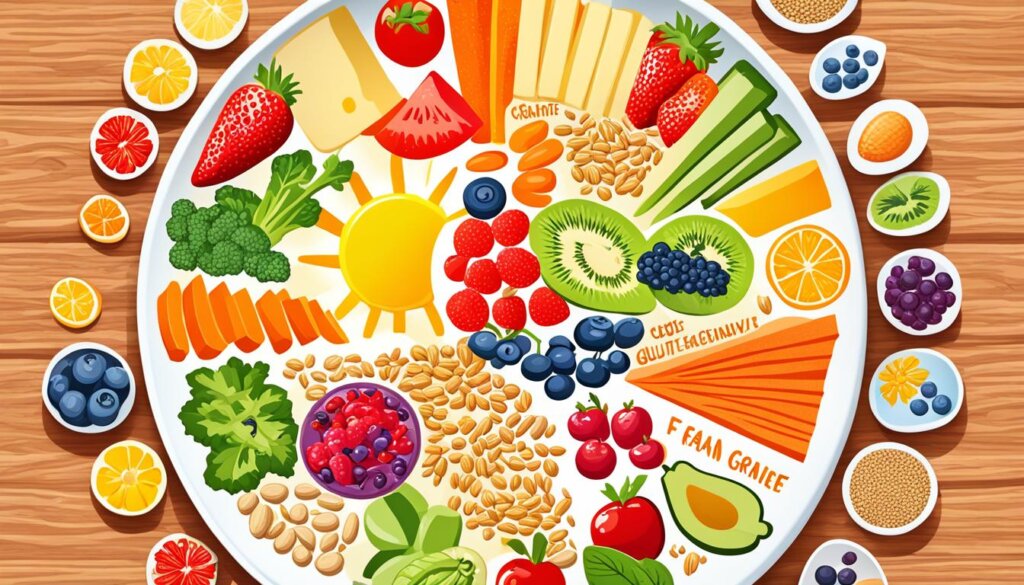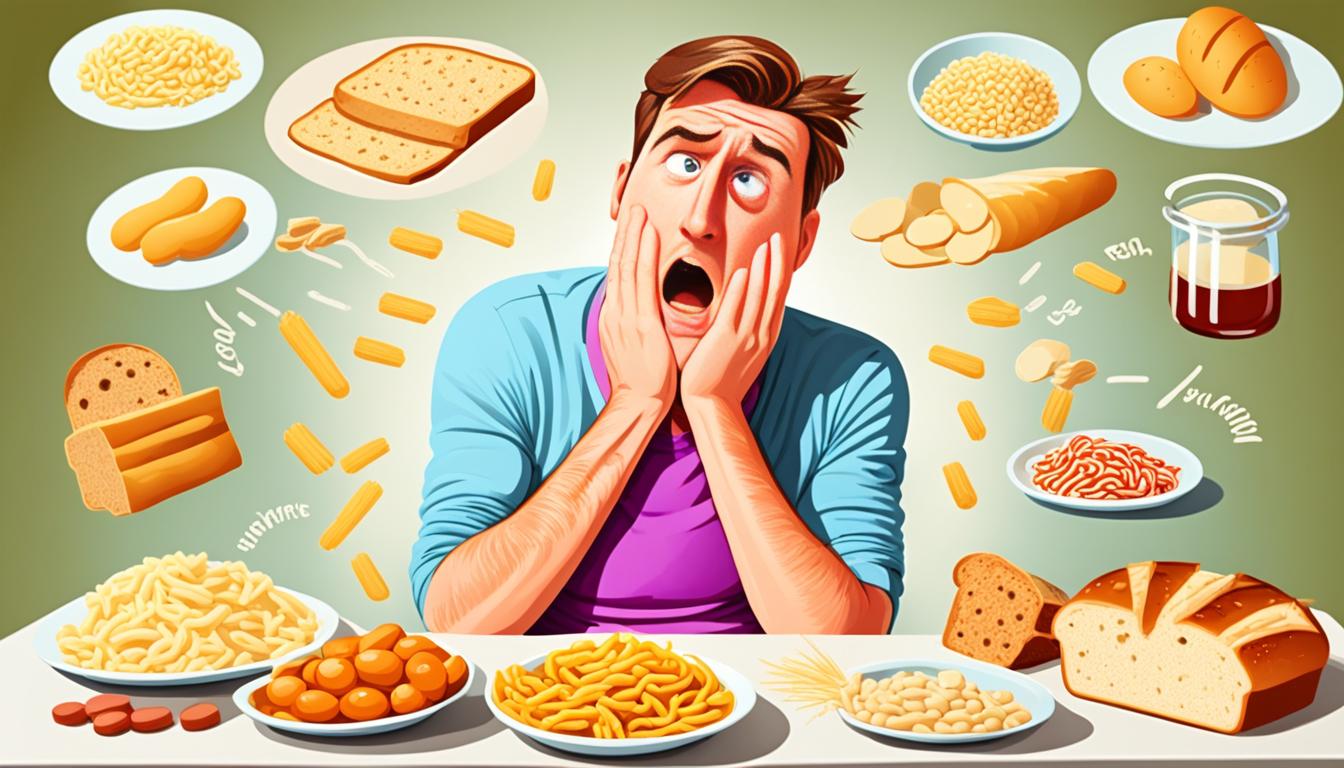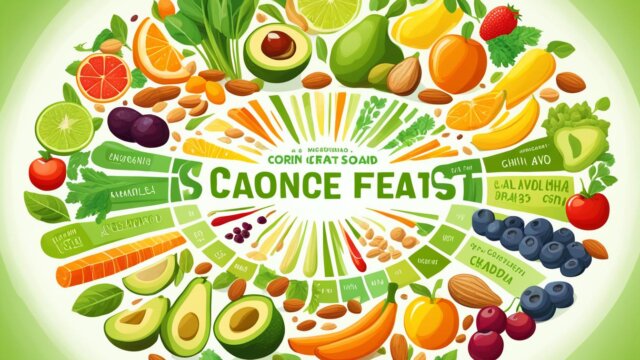FTC disclaimer: This post may contains affiliate links and we will be compensated if you click on a link and make a purchase.
Did you know that 0.5–13% of people might have gluten intolerance? This issue can make you feel bad and tired. Symptoms like bloating and diarrhea can really affect your life. But, knowing the signs, getting tested, and avoiding certain foods can help you feel better.
Key Takeaways
- Gluten intolerance affects up to 13% of people.
- Symptoms include bloating, diarrhea, and headaches.
- You must rule out celiac disease and wheat allergy.
- An elimination diet can show if gluten is the problem.
- Avoiding certain grains is the main way to treat it.
Overview of Gluten Intolerance
Gluten is a protein in wheat, barley, rye, and some grains. It can cause problems for people with gluten intolerance. This is different from celiac disease, which harms the small intestine. Gluten intolerance is not fully understood but may cause inflammation and stomach issues.
Understanding Gluten and Its Effects
People with gluten intolerance may feel sick after eating gluten. Symptoms include belly pain, tiredness, gas, diarrhea, constipation, headaches, joint pain, and rashes. It’s not as serious as celiac disease, which can harm the small intestine badly.
Prevalence of Gluten Intolerance
About 1% of people in the U.S. have celiac disease, 1% have a wheat allergy, and 6% have gluten intolerance. Also, 10-15% of adults have irritable bowel syndrome (IBS) linked to gluten intolerance.
Gluten intolerance is not as bad as celiac disease or wheat allergy. But, it’s still important to manage it for better health.
“Experts highlight the importance of tests that can accurately identify gluten intolerance to distinguish it from celiac disease, IBS, and other intestinal conditions.”
To handle gluten intolerance, see healthcare pros for a correct diagnosis and diet plan. Avoiding gluten can help reduce symptoms and boost life quality.
Gastrointestinal Symptoms of Gluten Intolerance
Gluten intolerance often leads to stomach problems. People may feel bloated, have diarrhea, constipation, and pain in their belly after eating foods with gluten. These symptoms can make everyday life hard and happen often.
These digestive issues can be bad, causing some to have stools that smell badly because they’re not getting nutrients well.
Kids with gluten intolerance might feel nauseous, have diarrhea, or constipation. They might also have a swollen belly, gas, and have stools that look pale and smell bad. Adults can have diarrhea, lose weight, feel tired, and have headaches or joint pain.
| Gastrointestinal Symptoms of Gluten Intolerance |
|---|
| Bloating |
| Diarrhea |
| Constipation |
| Abdominal Pain |
| Nausea or Upset Stomach |
| Vomiting |
| Unpleasant-Smelling Stools |
These symptoms can start within a few hours or a day after eating foods with gluten. If you have these issues, see a doctor to figure out what’s wrong. They can tell you if it’s gluten intolerance, celiac disease, wheat allergy, or irritable bowel syndrome.
“Gluten intolerance is similar to celiac disease in symptoms but does not cause permanent damage to the small intestine.”
Non-Gastrointestinal Symptoms
Many people think of gluten intolerance as just stomach issues. But it can also cause other problems. These include feeling very tired and getting headaches often. Some folks might get joint pain, skin rashes, feel foggy in the head, or have nerve problems like neuropathy.
Fatigue and Headaches
Feeling very tired without a good reason is common with gluten intolerance. The body can’t handle gluten well, making you feel tired and low on energy. Headaches that keep coming back are also common. They happen because the body gets inflamed from eating gluten.
Joint Pain and Other Symptoms
Joint pain, skin rashes, and nerve issues like neuropathy can happen too. The immune system reacting to gluten can make joints hurt. Skin problems like a rash called dermatitis herpetiformis are also linked to gluten. Some people might feel brain fog, have trouble focusing, or feel numbness or tingling in their hands and feet.
It’s important to know that gluten intolerance can cause more than just stomach problems. Being aware of these other symptoms can help with getting diagnosed and treated sooner.
“Untreated celiac disease can lead to complications such as malnutrition, bone weakening, infertility, lactose intolerance, cancer, and nervous system conditions.”
Distinguishing Gluten Intolerance from Celiac Disease
Gluten intolerance and celiac disease both involve issues with gluten. But, they are not the same. Celiac disease is an autoimmune disorder that harms the small intestine when gluten is eaten. It causes serious symptoms like bad digestion, not getting enough nutrients and other health issues.
Gluten intolerance, though, doesn’t cause the same damage or health problems. It still makes people feel bad, but not as badly as those with celiac disease.
Differences in Symptoms and Severity
Celiac disease is a serious issue that needs a doctor’s check-up. Doctors use blood tests to see if the body has antibodies, and might do more tests to check for intestine damage. People with celiac disease must eat gluten-free to stay healthy and avoid more problems.
Gluten intolerance, or NCGS, doesn’t harm the intestines or overall health as much. It can cause symptoms like bloating and joint pain, but they’re not as bad. It’s not an autoimmune disorder and doesn’t run in families like celiac disease.
Diarrhea right away might mean gluten intolerance, not celiac disease. Some people with gluten intolerance might feel better by eating less gluten. But, those with celiac disease must eat gluten-free for good health.
Characteristic | Celiac Disease | Gluten Intolerance |
|---|---|---|
Mechanism | An autoimmune disorder that damages the small intestine | Does not cause intestinal damage |
Symptoms | Severe digestive issues, malnutrition, and other serious health problems | Less severe symptoms, such as bloating, brain fog, and joint pain |
Diagnosis | Blood tests, endoscopy, and biopsy | Elimination diet and monitoring of symptoms |
Management | Strict gluten-free diet | Cutting back on gluten-containing foods may be sufficient |
It’s important to know the differences between gluten intolerance and celiac disease for the right diagnosis and care. Both affect gluten, but the impact and long-term effects are very different.

Testing for Gluten Intolerance
Figuring out if someone has gluten intolerance is tricky. Doctors first check for serious issues like celiac disease and wheat allergy. They use blood tests to look for signs of celiac disease. Sometimes, they might need to do an intestinal biopsy.
After ruling out serious conditions, doctors might suggest an elimination diet. This means taking gluten out of the diet to see if symptoms go away. Watching how symptoms change can help tell if gluten is the problem.
Ruling Out Celiac Disease and Wheat Allergy
First, doctors must check for celiac disease, a serious condition. Most people with celiac disease have certain genetic traits found in many Caucasians. To diagnose, they do blood tests and biopsies.
Doctors might also try a gluten challenge. This means eating foods with gluten for a few weeks and then testing the blood again.
Doctors also think about wheat allergy, which can cause similar symptoms. Tests can rule out celiac disease, but they’re not always right. An endoscopy and biopsies can confirm celiac disease.
There’s no special test for gluten sensitivity yet. Doctors diagnose it by seeing if symptoms get better without gluten. Some studies link gluten sensitivity to irritable bowel syndrome.
“Diagnosing gluten intolerance can be a complex process, as healthcare professionals must first rule out more serious conditions like celiac disease and wheat allergy.”
Gluten Intolerance and Elimination Diet
Managing gluten intolerance often means trying an elimination diet. This means taking all gluten out of your diet for a bit to see what foods make your symptoms worse. This diet usually lasts 5–6 weeks. You’ll watch how your body reacts to see if you feel better.
The diet can help find out which foods bother you. After the diet, you can start adding gluten foods back in one by one. This helps you see which ones make you sick. It can show if you need a gluten-free diet or if you can avoid certain foods to feel better.
Not everyone with gluten intolerance needs a gluten-free diet. But, the diet can still be helpful. It can tell you what foods you’re sensitive to. Up to 20% of people might have food intolerances. This diet is a good first step to find out what’s right for you.

It’s smart to work with a doctor or dietitian when you start this diet. They can tell you what foods to skip and how to add them back in safely. They also help you eat well during the diet. With their help, you can understand your gluten intolerance better and control your symptoms with food.
Elimination Diet Phases | Duration | Purpose |
|---|---|---|
Phase 1 (Elimination) | 2 weeks | Completely remove gluten-containing foods to observe if symptoms improve |
Phase 2 (Reintroduction) | Up to 10 weeks | Slowly reintroduce gluten-containing foods one at a time to identify trigger foods |
Maintenance | Ongoing | Adhere to a personalized diet based on the results of the elimination and reintroduction phases |
By being careful with your diet, you can learn a lot about your gluten intolerance. This helps you make smart choices about what to eat. It can help you feel better and live a healthy life.
Managing Symptoms Through Diet
For people with gluten intolerance, the main treatment is a diet without gluten. This means avoiding foods like wheat, barley, rye, and their products. It’s important to check food labels for hidden gluten in many foods, such as bread, pasta, cereals, and some sauces.
There are many gluten-free foods that are good for a healthy diet. These include fruits, veggies, beans, nuts, and gluten-free grains like quinoa, rice, and buckwheat. With some effort and planning, people with gluten intolerance can manage their symptoms well.
Identifying and Avoiding Gluten-Containing Foods
- Naturally gluten-free foods include unprocessed meat, fish, poultry, eggs, beans, seeds, raw nuts, fruits, vegetables, and most dairy products.
- Gluten can also be found in non-food items such as cosmetics, toothpaste, deodorant, and medications.
- Cross-contamination, especially in manufacturing processes, is a concern for people adhering to a strict gluten-free diet.
- Specific grains to avoid for a gluten-free diet include barley, rye, triticale, farina, graham flour, and semolina.
- Corn and rice products may be contaminated with wheat gluten if processed in the same facilities.
- Oats can be consumed as long as they are not contaminated with wheat gluten.
- Label reading is essential to avoid hidden gluten in products like beer, candy, sauces, and soups.
- Separating kitchen tools for preparing gluten and gluten-free foods is recommended.
- Individuals should inquire about gluten in medications, as it can be used as an additive in various products.
By being careful about what foods have gluten, people with gluten intolerance can handle their symptoms better. This helps them stay healthy and balanced.
“Ingesting even tiny amounts of gluten may cause symptoms and intestinal damage in individuals with celiac disease.”
Following a gluten-free diet can be hard, but with the right help and support, people with gluten intolerance can do it. This can greatly improve their health and happiness.
Gluten-Free Alternatives | Gluten-Containing Ingredients to Avoid |
|---|---|
Quinoa, rice, buckwheat, corn, potatoes, beans, nuts, seeds | Wheat, barley, rye, triticale, farina, graham flour, semolina |
Fruits, vegetables, unprocessed meat, poultry, fish, eggs, dairy | Breads, pastas, cereals, sauces, condiments, beer, candy |
Gluten-Free Diet and Lifestyle
Starting a gluten-free diet means big changes in your life. But, with good strategies, it gets easier. About 6% of people worldwide have gluten sensitivity. And 1% of people have celiac disease and need a strict gluten-free diet.
Meal Planning and Grocery Shopping
Planning meals and shopping for groceries are key to a gluten-free life. You need to read food labels well, find gluten-free substitutes, and keep your pantry full of safe foods.
People with gluten issues like celiac disease or non-celiac gluten sensitivity must avoid gluten in wheat, barley, and rye. It’s safer to eat certified gluten-free oats, and most distilled drinks are gluten-free. But, most beers and malted drinks have gluten.
At first, a gluten-free diet might seem hard. But, it can become easy with time and practice for those who need it. Some people lose weight on this diet because they eat fewer processed foods. But, gluten-free processed foods can be high in sugar and fat. Eating more whole grains can lower cholesterol and blood sugar, helping with heart and diabetes risks.
Some people might feel sick or anxious when they first stop eating gluten. These feelings usually go away in a few weeks. It’s a good idea to talk to a doctor or dietitian before starting a gluten-free diet, especially if you have celiac disease or gluten intolerance.
Dining Out with Gluten Intolerance
Dining out can be tough for those with gluten intolerance. There’s a big risk of cross-contamination and hidden gluten in food. But, with the right strategies, you can still enjoy safe and tasty meals while sticking to your diet.
First, find restaurants that are gluten-free friendly. Look for places with special gluten-free areas and menus. Or, check if they’re part of the GFFS Validation Program. It’s also key to tell the staff about your diet. They can help pick safe menu items and make sure your food is handled right.
When eating out, go for foods that don’t have gluten naturally. Think grilled meats, steamed veggies, and simple salads. Avoid things like sauces, dressings, and fried foods that might have gluten. If you can, call the restaurant first to talk about gluten-free options. They might even make a special dish for you.
Eating during quiet times can help too. The staff might have more time to focus on your gluten-free needs. When you order, tell the staff about your diet and ask that your food be made safely.
Even with care, there’s still a chance of gluten exposure when eating out. Always check your order with the server to make sure it’s gluten-free. Watch out for things like salad dressings, marinades, and soups. These can have hidden gluten.
By being careful and communicating with the staff, you can enjoy eating out with gluten intolerance. Remember, doing your homework, talking to the staff, and paying attention to details are key for a safe and fun meal out.
Restaurant Type | Gluten-Free Considerations |
|---|---|
Fast Food / Quick Service | Limited time to thoroughly check ingredients for gluten, higher risk of cross-contact |
Finer Dining | More relaxed atmosphere, chefs are generally knowledgeable about gluten, more accommodating for gluten-free diners |
“Despite following safety tips, there is still a risk of inadvertent gluten exposure when dining out, highlighting the importance of choosing validated establishments for gluten-free options.”
Gluten Intolerance and Nutritional Deficiencies
People with gluten intolerance might not get all the nutrients they need if they don’t eat well. Cutting out foods like bread and pasta can mean not getting enough vitamins and minerals. To fix this, eating a variety of gluten-free foods like fruits, veggies, lean meats, and gluten-free grains is key.
Maintaining a Balanced Diet
Doctors might suggest supplements to make sure you get enough nutrients. Planning meals and talking to a dietitian can help keep a gluten-free diet balanced.
Vitamin A needs are 2300 IU for women and 3000 IU for men. Iron needs change with age, from 8-18mg a day for adults. But, some people have a condition called hemochromatosis that can make too much iron harmful.
Vitamin D needs are 400-600 IU a day, with limits of 1000 IU to 4000 IU based on age. Not getting enough vitamin D is common, so many people take supplements.
Supplements can be dangerous if not watched closely by a doctor. A person on a gluten-free diet got too much vitamin B6 from taking too many supplements.

“Maintaining a balanced, nutrient-rich diet is essential for individuals with gluten intolerance to avoid potential deficiencies and support overall health.”
By eating a variety of gluten-free foods and getting advice from health experts, people with gluten intolerance can stay healthy and manage their condition well.
Coping Strategies for Gluten Intolerance
Living with gluten intolerance can change your life a lot. But, there are ways to make it easier. Getting support from family, friends, or groups can really help. They can offer advice and understanding as you eat gluten-free.
Learning about gluten intolerance and speaking up for your needs can make you feel stronger. It helps you handle the challenges of eating gluten-free. Staying positive and focusing on what you can eat can also make a big difference.
Planning meals, eating out, and telling others about your needs can ease social challenges. With a good support network and the right strategies, you can deal with the physical, emotional, and social parts of gluten intolerance. This way, you can live a happy and healthy life.
“The key to managing gluten intolerance is to be prepared, stay positive, and surround yourself with a supportive network. With the right strategies, you can thrive and enjoy life to the fullest.”
Coping Strategies | Benefits |
|---|---|
Seek Emotional Support | Navigate social and emotional challenges |
Practice Stress Management | Manage physical and mental impacts |
Educate and Advocate | Take control of your health and find solutions |
Plan Meals and Dining Out | Overcome social challenges with a gluten-free diet |
Dealing with gluten intolerance needs a lot of effort, but these strategies can help. By using them, you can become strong and flexible. Remember, you’re not alone, and there’s help out there to make this change easier.
Gluten Intolerance
Understanding and managing gluten intolerance is getting better as we learn more about it. Researchers are finding new things about this condition. They are looking into how it works, how common it is, and how to spot it.
There’s still a lot to discover, but new ideas like biomarkers and special enzymes could help people with gluten intolerance. As scientists learn more, people with gluten intolerance can get the best advice from doctors to feel better and stay healthy.
Recent Research and Developments
Studies say gluten intolerance affects 0.5–13% of people. Finding out exactly how many is still a work in progress. But, more people know about it, which has led to new ways to test and treat it.
Scientists are working on finding reliable tests for gluten intolerance. Right now, doctors first rule out other conditions before saying someone has gluten intolerance. They’re looking for special signs to tell gluten intolerance apart from other issues.
They’re also looking at new ways to help people with gluten intolerance. Using special enzymes might help some people eat a little gluten. These new ideas, along with better gluten-free foods, give hope for a better life for those affected.

As we learn more about gluten intolerance, people with it can feel hopeful. The health world is working hard to make better tests and treatments. By keeping up with new research and talking with doctors, those with gluten intolerance can find the best ways to feel better and stay healthy.
Conclusion
Gluten intolerance, or non-celiac gluten sensitivity, causes many symptoms. These include stomach issues and even headaches. It’s different from celiac disease, which affects only 0.7–1% of people. Yet, managing gluten intolerance needs careful diet and lifestyle changes.
To handle it, you must avoid foods with gluten and try an elimination diet. Eating out and getting enough nutrients is also key. As research grows, people with gluten intolerance can work with doctors to manage their symptoms better.
Gluten intolerance affects 0.5% to 13% of people. The gluten-free market is expected to hit $4.7 billion in 2020. By learning about symptoms, tests, and how to eat, those with gluten intolerance can improve their health.
FAQ
What is gluten intolerance?
Gluten intolerance is when the body can’t digest gluten, a protein in some grains. It leads to symptoms like stomach problems and other issues.
How is gluten intolerance different from celiac disease?
Celiac disease is a serious condition that causes the small intestine to get damaged by gluten. Gluten intolerance doesn’t cause this damage.
What are the common symptoms of gluten intolerance?
Symptoms include stomach problems like bloating and pain. You might also feel tired, have headaches, or pain in your joints and nerves.
How is gluten intolerance diagnosed?
Doctors first rule out celiac disease and wheat allergy with tests. Then, they might suggest an elimination diet to see if gluten is the cause.
How is gluten intolerance managed?
The main treatment is eating a gluten-free diet. This means avoiding foods with wheat, barley, and rye. It’s important to read labels and plan meals carefully.
Can gluten intolerance lead to nutritional deficiencies?
Yes, it can lead to nutrient shortages if not managed well. Eating a balanced gluten-free diet and taking supplements can help prevent this.
What are some coping strategies for managing gluten intolerance?
Getting support, managing stress, and learning about the condition help a lot. It’s also key to speak up about your dietary needs in different situations.
What are some recent developments in gluten intolerance research?
Researchers are finding new ways to understand and diagnose gluten intolerance. They’re looking into biomarkers and new treatments, like digestive enzymes, to help manage it better.








